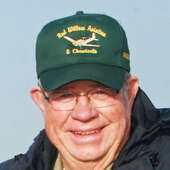- Sweatshirts, Jazzercise, and an unforgiving political climate (11/19/24)
- After the election: Lessons from history (11/5/24)
- Candy or cash: candidates and causes trick-or-treat for donations (10/29/24)
- You are fired! (10/1/24)
- Enduring heritage: Model Tís and Nebraskaís Unicam (9/24/24)
- YMCA project, coming changes and another attack (9/17/24)
- Class of '55 to share memories for Heritage Days (9/10/24)
Opinion
Hot air
Tuesday, July 14, 2009
Cleared for takeoff on 01Left. "Roger, Arrow 2077T cleared for takeoff," was the reply. I released brakes, lined up on the runway in my Piper Arrow and applied full power. RPM 2700, Manifold 27.5 inches Hg just like it should be. Nose up at 70 MPH, landing gear retracted and the airspeed increased to 105 MPH, for best rate of climb. Past the end of the runway and about 400 feet above the ground my RPM rolled back to about 2200 RPM and it dawned on me that things were no longer going well. I had just departed Richard Lloyd Jones Jr. Airport heading north up the Arkansas River and prospects of a good place to land were few. On the left stretching up from the river loomed a tree-covered hill higher than I at the moment. On the right was the Indian Casino and Oral Roberts University; neither a good place to land. I could have played Capt. Sully and ditched in the shallow river but I had another option that he was denied that day in New York. I banked hard right and after 180 degrees of turn was lined up to land down wind, 18 knots, on the runway parallel to the one I had so recently departed. Riverside Tower cleared me to land and my problems were over.
After turning off the runway I did a performance check on the engine and all seemed copasetic. On run-up the engine produced full power and I surmised that perhaps a little water had gotten into to the fuel during the several thunderstorms that hit South Tulsa, Okla., the two days prior. The next takeoff was normal and three hours later I happily touched down back home at McCook's Ben Nelson Regional Airport.
A week later I flew back to Tulsa to fetch Ann who had been "spoiling" grandkids all week. The day was hot and I had a fierce headwind from the south so elected to fly at the minimum altitude of 500 to 1000 feet above the ground. It was choppy and hot going but I was solo and put up with the discomfort. A benefit of the low-altitude flight was the magnificent view over green pastures with belly-deep grass, even darker green corn fields and wheat harvest in progress all across Kansas. It seemed to me that the engine wasn't putting out normal power but I chocked that up to the hot temperature. It was over 100 degrees when I landed at Jones, still known by the old name of Riverside Airport.
That was the 4th of July weekend and we celebrated big time with the grandkids. Fireworks are a tradition in my family and I bought plenty for the 11- and 13-year-olds to enjoy. That evening we watched a huge display put on by the merchants across the river in Jenks.
The view across the wide Arkansas River was extra good because of reflections on the water plus a big thunderstorm playing in the distance. Following that the kids and their dad burned the rest of their fireworks in the driveway.
Next day, Ann and I departed Riverside and the engine decided to act up again on takeoff. I stopped, ran it to full power and leaned the mixture and suddenly a good sized backfire and it went to full power. Brakes released and off we went for home, everything almost normal but again the nagging feeling that power output was a little lacking. Good flight though at 7500 feet altitude where we basked in the cool 50 degree outside air temperature.
Safely home it was time for the mechanic to check things out. Jeff was concerned over the apparent lack of power and finally found that the alternate air door had come loose and was wandering around in the intake system. Sometimes it blocked most of the airflow and sometimes only a portion. OK, on an airplane engine things are done a little differently than in the cars we drive daily. My Arrow's engine is fuel injected, just like modern automobiles, but the system design is ancient, crude and definitely not computer controlled. The intake air flows through a filter just like your car but the possibility exists that when flying through snow or ice crystals the filter can become restricted and choke off power. Not good. So a spring loaded flapper valve is installed downstream from the filter that opens when needed to allow the engine to breathe air that has already been heated by flowing over the cylinders. The pilot also has a control that forces the flapper valve (we call it the Alternate Air Door) open if required.
So my problem was not only a flapper valve wandering about partially blocking the intake air, my engine was also breathing hot air which also reduces power. "Only" 600 bucks later, the sole repair shop authorized to fix the item is in Canada, our Arrow should be good to go. Now if we can just get the pilot fixed as well life will be good.
That is the way I saw it.

